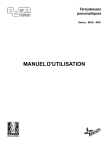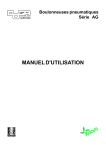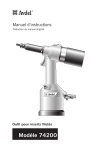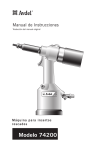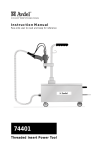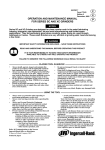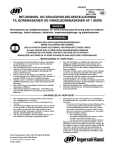Download Craftsman 310.26825 Owner`s manual
Transcript
Owner’s Manual CORDLESS IMPACT WRENCH 1/2" Drive 18 Volt High Performance Impact Wrench Model No. 310.26825 • • • • • Safety Operation Maintenance Parts Español, p.15 CAUTION: Before using this product, read this manual and follow all its Safety Rules and Operating Instructions. Sears, Roebuck and Co., Hoffman Estates, IL 60179 U.S.A. www.sears.com/craftsman TABLE OF CONTENTS WARRANTY ............................................................................ 2 GENERAL SAFETY RULES ................................................... 3 SPECIFIC SAFETY RULES AND SYMBOLS ........................ 5 OPERATION ........................................................................... 8 MAINTENANCE .................................................................... 12 PARTS ................................................................................... 14 ESPAÑOL .............................................................................. 15 WARRANTY FULL ONE YEAR WARRANTY If this Craftsman professional cordless impact wrench fails due to a defect in material or workmanship within one year from the date of purchase, Sears will repair it, free of charge. WARRANTY SERVICE IS AVAILABLE BY RETURNING THE TOOL TO THE NEAREST SEARS SERVICE CENTER IN THE UNITED STATES. This warranty gives you specific legal rights, and you may also have other rights which vary from state to state. Sears, Roebuck and Co., Dept. 817WA, Hoffman Estates, IL 60179 2 GENERAL SAFETY RULES ■ WARNING:Read and Personal Safety understand all instructions. Failure to follow all instructions listed below, may result in electric shock, fire and/or serious personal injury. ■ SAVE THESE INSTRUCTIONS Work Area ■ ■ ■ Keep your work area clean and well lit. Cluttered benches and dark areas invite accidents. Do not operate power tools in explosive atmospheres, such as in the presence of flammable liquids, gases, or dust. Power tools create sparks which may ignite the dust or fumes. Keep bystanders, children, and visitors away while operating a power tool. Distractions can cause you to lose control. ■ ■ Electrical Safety ■ ■ ■ Do not abuse the cord. Never use the cord to carry the charger. Keep cord away from heat, oil, sharp edges, or moving parts. Replace damaged cords immediately. Damaged cords may create a fire. A battery operated tool with integral batteries or a separate battery pack must be recharged only with the specified charger for the battery. A charger that may be suitable for one type of battery may create a risk of fire when used with another battery. Use listed battery only with charger listed. Use battery operated tool only with specifically designated battery pack. Use of any other batteries may create a risk of fire. Use only with battery pack. ■ ■ ■ 3 Stay alert, watch what you are doing and use common sense when operating a power tool. Do not use tool while tired or under the influence of drugs, alcohol, or medication. A moment of inattention while operating power tools may result in serious personal injury. Dress properly. Do not wear loose clothing or jewelry. Contain long hair. Keep your hair, clothing, and gloves away from moving parts. Loose clothes, jewelry, or long hair can be caught in moving parts. Avoid accidental starting. Be sure switch is in the locked or off position before inserting battery pack. Carrying tools with your finger on the switch or inserting the battery pack into a tool with the switch on, invites accidents. Remove adjusting keys or wrenches before turning the tool on. A wrench or a key that is left attached to a rotating part of the tool may result in personal injury. Do not overreach. Keep proper footing and balance at all times. Proper footing and balance enable better control of the tool in unexpected situations. Use safety equipment. Always wear eye protection. Dust mask, non-skid safety shoes, hard hat, or hearing protection must be used for appropriate conditions. ■ DEFINITIONS A. DANGER: Failure to obey a B. C. D. safety warning will result in serious injury to you or to others. Always follow the safety precautions to reduce the risk of fire, electric shock and personal injury. WARNING: Failure to obey a safety warming can result in serious injury to you or to others. Always follow the safety precautions to reduce the risk of fire, electric shock and personal injury. CAUTION: Failure to obey a safety warning may result in property damage or personal injury to you or to others. Always follow the safety precautions to reduce the risk of fire, electric shock and personal injury. NOTE: Advises you of information or instructions vital to the operation or maintenance of the equipment. ■ ■ ■ Tool Use and Care ■ ■ ■ ■ Use clamps or other practical way to secure and support the workpiece to a stable platform. Holding the work by hand or against your body is unstable and may lead to loss of control. Do not force tool. Use the correct tool for your application. The correct tool will do the job better and safer at the rate for which it is designed. Do not use tool if switch does not turn it on or off. A tool that cannot be controlled with the switch is dangerous and must be repaired. Disconnect battery pack from tool or place the switch in the locked or off position before making any adjustments, changing accessories, or storing the tool. Such preventive safety measures reduce risk of starting the tool accidentally. Store idle tools out of reach of children and other untrained persons. Tools are dangerous in the hands of untrained users. When battery pack is not in use, keep it away from other metal objects like: paper clips, coins, keys, nails, screws, or other small metal objects that can make a connection from one terminal to another. Shorting the battery terminals together may cause sparks, burns, or a fire. Maintain tools with care. Keep cutting tools sharp and clean. Properly maintained tools, with sharp cutting edges are less likely to bind and are easier to control. Check for misalignment or binding of moving parts, breakage of parts, and any other condition that may affect the tool’s operation. If damaged, have the tool serviced before using. Many accidents are caused by poorly maintained tools. Use only accessories that are recommended by the manufacturer for your model. Accessories that may be suitable for one tool, may create a risk of injury when used on another tool. Service ■ ■ 4 Tool service must be performed only by qualified repair personnel. Service or maintenance performed by unqualified personnel could result in a risk of injury. When servicing a tool, use only identical replacement parts. Follow instructIons in the Maintenance section of this manual. Use of unauthorized parts or failure to follow Maintenance Instructions may create a risk of shock or injury. SPECIFIC SAFETY RULES AND SYMBOLS Additional Rules For Safe Operation ■ ■ Know your power tool. Read operator’s manual carefully. Learn its applications and limitations, as well as the specific potential hazards related to this tool. Following this rule will reduce the risk of electric shock, fire, or serious injury. Make sure your extension cord is in good condition. When using an extension cord, be sure to use one heavy enough to carry the current your product will draw. A wire gage size (A.W.G.) of at least 16 is recommended for an extension cord 100 feet or less in length. A cord exceeding 100 feet is not recommended. If in doubt, use the next heavier gage. The smaller the gage number, the heavier the cord. An undersized cord will cause a drop in line voltage resulting in loss of power and overheating. ■ WARNING: • Hold tool by insulated gripping surfaces when performing an operation where the cutting tool may contact hidden wiring. Contact with a "live" wire will also make exposed metal parts of the tool "live" and shock the operator. • Use only impact sockets and accessories with these impact wrenches. Use of hand or power sockets will cause premature failure of the socket and possible injury to the user. Do not use chipped, cracked, or damaged sockets or accessories. Important Safety Instructions for Impact Wrench ■ ■ ■ Prolonged exposure to vibration, repetitive motions and uncomfortable positions can cause injury. Risk of entanglement. • Keep body parts away from moving parts. • Do not wear loose clothing and jewelry while operating tool. • Wear protective hair covering to contain long hair. • Do not carry tool with your finger on the trigger. • Remove adjusting keys or wrenches before turning the tool on. • Do not lock, tape, wire, etc., the trigger in the ON position. • Keep handle dry, clean and free from oil and grease. • Always shut off power and disconnect battery from tool when changing accessories. Entanglement can cause injury. Power tools can cause flying particles during use. Wear safety goggles, user and bystanders. Flying particles can cause injury. Power tools generate noise. Wear hearing protection, user and bystanders. Prolonged exposure to noise can cause hearing loss. Power tools vibrate. Avoid prolonged exposure to vibration, repetitive motions and uncomfortable positions. Stop using the tool if discomfort, tingling feeling or pain occurs. Seek medical advice before resuming use. 5 Important Rules for Battery Tools ■ ■ ■ ■ ■ ■ Battery tools do not have to be plugged into an electrical outlet; therefore, they are always in operating condition. Be aware of possible hazards when not using your battery tool or when changing accessories. Following this rule will reduce the risk of electric shock, fire, or serious personal injury. Do not place battery tools or their batteries near fire or heat. They may explode. Following this rule will reduce the risk of electric shock, fire, or serious personal injury. Do not charge battery tool in a damp or wet location. Following this rule will reduce the risk of electric shock, fire, or serious personal injury. Your battery tool should be charged in a location where the temperature is more than 50°F but less than 100°F. Following this rule will reduce the risk of electric shock, fire, or serious personal injury. Under extreme usage or temperature conditions, battery leakage may occur. If liquid comes in contact with your skin, wash immediately with soap and water, then neutralize with lemon juice or vinegar, If liquid gets into your eyes, flush them with clean water for at least 10 minutes, then seek immediate medical attention. Following this rule will reduce the risk of serious personal injury. ■ ■ ■ ■ ■ Important Safety Instructions For Charger ■ ■ Save these instructions. This manual contains important safety and operating Instructions for battery charger part number 9-11040 (981399-001). 6 Following this rule will reduce the risk of electric shock, fire, or serious personal injury. Before using battery charger, read all instructions and cautionary markings in this manual, on battery charger, and product using battery charger. Following this rule will reduce the risk of electric shock, fire, or serious personal injury. To reduce risk of injury, charge only nickel-cadmium and nickel metal hydride type recharge able batteries. Other types of batteries may burst causing personal injury and damage. Following this rule will reduce the risk of electric shock, fire, or serious personal injury. Do not expose charger to rain or snow. Following this rule will reduce the risk of electric shock, fire, or serious personal injury. Use of an attachment not recommended or sold by the battery charger manufacturer may result in a risk of fire, electric shock, or injury to persons. Following this rule will reduce the risk of electric shock, fire, or serious personal injury. To reduce risk of damage to charger body and cord, pull by charger plug rather than cord when disconnecting charger. Following this rule will reduce the risk of electric shock, fire, or serious personal injury. Make sure cord is located so that it will not be stepped on, tripped over, or otherwise subjected to damage or stress. Following this rule will reduce the risk of serious personal injury. An extension cord should not be used unless absolutely necessary. Use of improper extension cord could result in a risk of fire and electric shock. If extension cord must be used, make sure: ■ a.That pins on plug of extension cord are the same number, size and shape as those of plug on charger. b.That extension cord is properly wired and in good electrical condition; and c.That wire size is large enough for AC ampere rating of charger as specified below: Cord Length (Feet) 25’ 50’ 100’ Cord Size (AWG) 16 16 16 ■ Note: AWG = American Wire Gage ■ ■ ■ ■ Do not operate charger with a damaged cord or plug. If damaged, have replaced immediately by a qualified serviceman. Following this rule will reduce the risk of electric shock, fire, or serious personal injury. Do not operate charger if it has received a sharp blow, been dropped, or otherwise damaged in any way; take it to a qualified serviceman. Following this rule will reduce the risk of electric shock, fire, or serious personal injury. Do not disassemble charger; take it to a qualified serviceman when service or repair is required. Incorrect reassembly may result in a risk of electric shock or fire. Following this rule will reduce the risk of electric shock, fire, or serious personal injury. To reduce the risk of electric shock, unplug charger from outlet before attempting any maintenance or cleaning. Turning oft controls will not reduce this risk. Following this rule will reduce the risk of electric shock, fire, or serious personal injury. ■ Do not use charger outdoors. Following this rule will reduce the risk of electric shock, fire, or serious personal injury. Disconnect charger from power supply when not in use. Following this rule will reduce the risk of electric shock, fire, or serious personal injury. DANGER: RISK OF ELECTRIC SHOCK. DO NOT TOUCH UNINSULATED PORTION OF OUTPUT CONNECTOR OR UNINSULATED BATTERY TERMINAL. Save these instructions. Refer to them frequently and use them to instruct others who may use this tool. If you loan someone this tool, loan them these instructions also. Following this rule will reduce the risk of electric shock, fire, or serious personal injury. WARNING: Some dust created by power sanding, sawing, grinding, drilling, and other construction activities contains chemicals known to cause cancer, birth defects or other reproductive harm. Some examples of these chemicals are: • lead from lead-based paints • crystalline silica from bricks and cement and other masonry products, and • arsenic and chromium from chemically-treated lumber. Your risk from these exposures varies, depending on how often you do this type of work. To reduce your exposure to these chemicals: work in a well-ventilated area, and work with approved safety equipment, such as those dust masks that are specially designed to filter out microscopic particles. 7 SYMBOLS Symbol Name . Direct Current Type or a characteristic of current Designation/ Explanation V Volts Voltage A Amperes Current Hz Hertz Frequency (cycles per second) min Minutes Time Alternating Current Type or a characteristic of current no .../min No Load Speed Rotational speed, at no load Revolutions or Revolutions, strokes, Reciprocation surface speed, orbits Per Minute etc. per minute Safety Alert Symbol Indicates danger, warning, or caution. It means attention!!! Your safety is involved. OPERATION APPLICATION Before attempting to use your impact wrench, familiarize yourself with all operating features and safety requirements. The Craftsman Impact Wrench is ideal for a wide variety of fastener turning jobs in both automotive and industrial fields. When used with impact sockets, it provides power and speed for greater job efficiency and less operator fatigue. Applications include assembly line operations, removal of rusted-on nuts and bolts and many other specialized uses. WARNING: To avoid serious injury carefully read through this entire owner's manual before using your new impact wrench. Pay close attention to the Rules For Safe Operation, Warnings and Cautions. If you use your impact wrench properly and only for what it is intended, you will enjoy years of safe, reliable service. KNOW YOUR IMPACT WRENCH WARNING: Do not allow familiarity with your impact wrench to make you careless. Remember that a careless fraction of a second is sufficient to inflict severe injury. SWITCH TRIGGER To turn your impact wrench ON, depress the switch trigger. Release switch trigger to turn your impact wrench OFF. Figure 1: Impact Wrench Features A. B. C. D. Forward/Reverse Selector Switch Trigger Battery Pack Wrist Strap Figure 2: Switch Trigger 8 SWITCH LOCK The switch trigger can be locked in OFF position. This feature helps reduce the possibility of accidental starting when not in use. VARIABLE SPEED This tool has variable speed switch that delivers higher speed with increased trigger pressure. Speed is controlled by the amount of switch trigger depression. FORWARD/REVERSE SELECTOR (DIRECTION OF ROTATION SELECTOR) Figure 4: Battery Pack Installation • Align raised ribs on battery pack with grooves on bottom of impact wrench, and then attach battery pack to impact wrench. • Make sure latch on battery pack snaps into place and battery pack is secured to impact wrench before beginning operation. Your impact wrench has a forward/ reverse selector located above the switch trigger. CAUTION: When attaching battery pack to your impact wrench, be sure raised ribs and grooves align properly and latch snaps into place properly. Improper assembly can cause damage to impact wrench and battery pack. Figure 3:Forward/Reverse Selector and Trigger A. B. Forward/Reverse Selector Switch Trigger TO REMOVE BATTERY PACK FROM IMPACT WRENCH WRIST STRAP A wrist strap is provided to reduce the chances of dropping your impact wrench. Place one hand through the wrist strap when carrying tool. TO ATTACH BATTERY PACK TO IMPACT WRENCH NOTE:Battery pack is shipped in a low charge condition. Therefore, it must be charged prior to use. Refer to charging instructions. Figure 5: Battery Pack Removal 9 • Lock the switch trigger by placing FORWARD/REVERSE SELECTOR in the center position. • Depress latch located on front of battery pack (1) to release battery pack. • Pull forward on battery pack (2) to remove from impact wrench. WARNING: If any parts are missing, do not operate your impact wrench until the missing parts are replaced. Failure to do so could result in possible serious personal injury. Figure 6: Battery Charger TO CHARGE • Charge battery pack only with the charger provided. • Make sure power supply is normal house voltage, 120 volts, 60 Hz, AC only. • Connect charger to power supply. • Attach battery pack to charger by aligning raised ribs on battery pack with grooves in charger, then slide battery pack onto charger. • Red light should turn on. Steady red light indicates normal fast charging mode. If red light is flashing, this indicates battery pack is deeply discharged or hot. If battery pack is hot, red light should become steady after battery pack has cooled down. If battery pack is deeply discharged, red light should become steady after voltage has increased, normally within 60 minutes. If after one hour red light is still flashing, this indicates a defective battery pack that should be replaced. Green light ON indicates battery pack is fully charged and slow charging to maintain battery pack. Yellow light ON and red light flashing indicates defective battery pack. Return battery pack to your nearest Sears Repair Center for checking or replacing. WARNING: Always wear safety goggles or safety glasses with side shields when operating tools. Failure to do so could result in objects being thrown into your eyes, resulting in possible serious injury. CHARGING BATTERY PACK The battery pack for this tool has been shipped in a low charge condition to prevent possible problems. Therefore, you should charge it until light on front of charger changes from red to green. NOTE:Batteries will not reach full charge the first time they are charged. Allow several cycles (using impact wrench followed by recharging) for them to become fully charged. 10 • When your battery pack becomes fully charged, the red light will turn OFF and the green light will turn ON. • A minimum charge time of 1-1/2 hours is required to recharge a completely discharged battery. • The battery pack will become slightly warm to the touch while charging. This is normal and does not indicate a problem. • Do not place charger in an area of extreme heat or cold. It will work best at normal room temperature. • When the batteries become fully charged, unplug your charger from power supply and remove the battery pack. Figure 7: Indicator Lights A. B. C. Defective Battery Indicator Light Charging Indicator Light Ready Indicator Light LED FUNCTION OF CHARGER IMPORTANT INFORMATION FOR RECHARGING HOT BATTERIES LED WILL BE LIGHTED TO INDICATE STATUS OF CHARGER AND BATTERY PACK: • Red LED Lighted = Fast Charging Mode. • Green LED Lighted = Fully Charged and Slow Charging to Maintain Battery Pack. • Red LED Flashing = Hot Or Deeply Discharged Battery Pack. Also Defective Battery Pack After1 Hour. • Yellow LED Lighted and Red LED Flashing = Defective Battery Pack. Under lengthy continuous use, the batteries in your battery pack will become hot. You should let a hot battery pack cool down for approximately 1 hour before attempting to recharge. When the battery pack becomes discharged and is hot, this will cause the red light on your battery charger to flash. When the battery pack cools down, red light will glow continuously indicating fast charging mode, 1 hour charge time. Once the battery pack cools down, it will recharge battery pack in fast charging mode as normal. 11 MAINTENANCE Product Specifications Craftsman Impact Wrench WARNING: Do not at any time let brake fluids, gasoline, petroleum-based products, penetrating oils, etc. come in contact with plastic parts. They contain chemicals that can damage, weaken, or destroy plastic. Model 310.26825 Motor voltage 18 VDC Square drive size 1/2" Tightening torque* 180 ft. lb. Sound pressure level** 96 dbA Sound power level 109 dbA Vibration Level*** 5.5 m/sec2 Free speed 0–2200 RPM Impact per minute 2220 IPM Weight with one battery pack 6.5 lbs. Do not abuse power tools. Abusive practices can damage tool as well as work piece. Only the parts shown on the parts list are intended to be repaired or replaced by the customer. All other parts should be replaced at a Sears Service center. Weight of one battery pack 2.4 lbs. Current draw, free speed 8.7 A Current draw during impacting 38 A WARNING: Do not attempt to modify this tool or create accessories not recommended for use with this tool. Any such alteration or modification is misuse and could result in a hazardous condition leading to possible serious personal injury. *Output torque is tested with Skidmore mode RL with 3/4" bolt (impacting for 5 seconds). **Sound levels are tested per ISO standards 3744 and Pneurop test code PN8NTC1. Tool loaded per ISO standard 8662. ***Vibration level tested per ISO standard 8662-8. BATTERIES Charger Item No. The battery pack for your impact wrench is equipped with nickel-cadmium rechargeable batteries. Length of service from each charging will depend on the type of work you are doing. The batteries in this tool have been designed to provide maximum trouble free life. However, like all batteries, they will eventually wear out. Do not disassemble battery pack and attempt to replace the batteries. 9-11040 (981399-001) Charging Voltage 9.6 - 24 V Charge Rate 1 hr Battery Pack Item No. 9-11034 (981404-001) ACCESSORIES The recommended 1/2" drive impact sockets are currently available at Sears Retail Stores. WARNING: Handling of these batteries, especially when wearing rings and jewelry, could result in a serious burn. WARNING: Use of hand socket will cause premature failure of socket and possible injury to the user. 12 To obtain the longest possible battery life, we suggest the following: • Store and charge your batteries in a cool area. Temperatures above normal room temperature will shorten battery life. • Never store batteries in a discharged condition. Recharge them immediately after they are discharged. • All batteries gradually lose their charge. The higher the temperature, the quicker they lose their charge. If you store your tool for long periods of time without using it, recharge the batteries every month or two. This practice will prolong battery life. To preserve natural resources, please recycle or dispose of batteries properly. This product contains nickel-cadmium batteries. Local, state or federal laws may prohibit disposal of nickel-cadmium batteries in ordinary trash. Consult your local waste authority for information regarding available recycling and/or disposal options. BATTERY PACK REMOVAL AND PREPARATION FOR RECYCLING WARNING: Upon removal for disposal, cover the battery pack's terminals with heavy-duty adhesive tape. Do not attempt to destroy or disassemble battery pack or remove any of its components. Nickel-cadmium batteries must be recycled or disposed of properly. Also, never touch both terminals with metal objects and/or body parts as short circuit may result. Keep away from children. Failure to comply with these warnings could result in fire and/or serious injury. 13 PARTS Craftsman 1/2" Professional Cordless Impact Wrench Model No. 310.26825 The model number will be found on a plate attached to the motor housing. Always mention the model number in all correspondence regarding your CRAFTSMAN 1/2" PROFESSIONAL CORDLESS IMPACT WRENCH or when ordering repair parts. SEE BACK PAGE FOR PARTS ORDERING INSTRUCTIONS Key No. Part Number Description Quantity 1 9-11034** Battery Pack - 18V 1 2 9-11040** Battery Charger 1 ZCTS1850* Owner’s Manual 1 ZCTS1850-119 Label (Logo Plate) PB156* Carrying Case 3 * Item not shown. ** Can be purchased at your nearest Sears Retail Store. 14
















